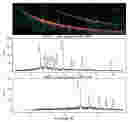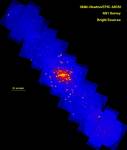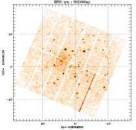

[with acknowledgments to the European Space Agency]
This page contains information on some of the early images obtained by XMM-Newton. For more recent images please visit the ESA site at sci.esa.int/xmm.
Please click on image for pop up
This shows a section of the x-ray sky obtained with the pn camera and on the right, part of the same section of the sky, to the same scale, obtained in visible light with the optical monitor.
A group of galaxies can be very clearly seen in the optical monitor, and then x-ray counter parts can also be seen in the left hand image. On the other hand, it is immediately obvious that there are big differences in the appearance of the sky in the two wave-bands
The images are centered on a group of galaxies known as a Hickson Compact Group - HCG16 for short. Most galaxies occur in groups of up to 30 galaxies, or in clusters of up to a few thousand galaxies. Some of the x-ray emission comes, as in this picture, from the galaxies in the cluster or group, but some also comes from a hot ball of gas (not visible here) which often surrounds the group or cluster.
Please click on image for pop up
This is a picture of a region, called 30 Doradus, in the large Magellanic Cloud. We live in the Milky Way, a galaxy containing 100,000,000,000 stars. Our nearest neighbour galaxy is the large Magellanic Cloud (MC). The x-ray binaries from the MC come from binary systems and supernova remnants - both are present in this image.
Please click on image for pop up
The diffraction grating in the RGS (reflection grating spectrometer) spreads the x-rays of different wavelengths into an arc on the detector. This can be seen in the inset picture. Actually, these are two such arcs, corresponding to the first order and second order diffraction; to a first approximation the deflection in the second order is twice that in the first. It can be seen that there are bright points on the arcs where the x-rays are concentrated at particular wavelengths. The graphs show the intensity of the x-rays as a function of wavelength; hence the bright points show up as peaks. The peaks are due to the lines characteristic of different elements present in the x-ray source - iron (FE), oxygen (O) and so on.
These observations were taken on the star HR1099, which is actually not a single star, but a binary system of two stars orbiting about one another.
Up to date images
This is an image taken by the EPIC MOS camera of M31, The Andromeda galaxy. This is our closest neighboring spiral galaxy at a distance of 2.6 million light years away. The images shows bright X-ray sources
distributed along the disk of the galaxy. As you can see most of them are in the centre of the galaxy, located in the galactic bulge. Click on image for pop up
Most of the newly discovered sources are unlike the other ones in hat they are neutron star binaries accreting matter from low mass late type stars. For more information about these observations visit The image shows the appearance of SN2002 ap. The exposure was taken on Feb. 2nd 2002 with the EPIC pn camera using a 37 ksec exposure time.
The optical image of the region surrounding SN2002 ap can be found
here
IMAGE - GRB011211
This gamma ray burst was selected as a target of opportunity after beppoSAX spotted it. The telescope was pointed
in the direction of the GRB but is was found after a 4 ksec exposure that the target lay in the gap between 2 CCD's
and so the telescope was re-pointed for the duration of the exposure. IMAGE - RX J1120.1+4318 XMM observed this x-ray cluster back in May 2002 with a 20 ksec exposure. The data was used to measure the temperature of the x-ray emitting gas in the
cluster's potential well. The resulting plot is shown
here
Further XMM images can be found at sci.esa.int/xmm and at xmmssc-www.star.le.ac.uk
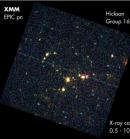
IMAGE- Composite image of EPIC-PN false colour X-ray (left) and OM-V
filter (right)
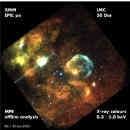
IMAGE- EPIC PN False colour x-ray image of the Doradus region in the large Magellanic Clouds
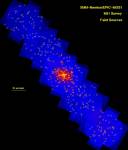 With XMM, the most powerful x-ray telescope in orbit, new faint x-ray sources in the disk of the galaxy can be observed. Most of theses sources
were previously undetected before XMM took these images earlier in 2002.
With XMM, the most powerful x-ray telescope in orbit, new faint x-ray sources in the disk of the galaxy can be observed. Most of theses sources
were previously undetected before XMM took these images earlier in 2002.
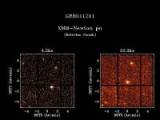
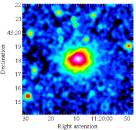
![]()
